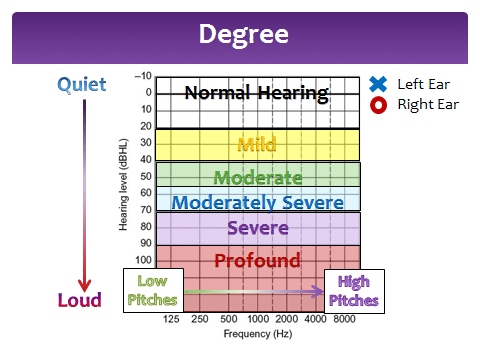What is an audiogram?
You have taken the first steps towards addressing your hearing loss and had your hearing tested, but what do the results mean?
After you have had your hearing tested, the results should be explained to you by the audiologist during your appointment. However, sometimes it is difficult to remember what it all means. Here is some helpful information for understanding your test results.
Your results will be presented on an audiogram, which is essentially a graph of the softest sounds that you can hear. The audiogram is laid out like a piano across the top with the low frequencies (low pitches) on the left and the high frequencies (high pitches) on the right.
The vowel sounds in speech tend to be low pitch sounds and the consonants tend to be high pitch sounds. One helpful tip to remember is that Vowels bring Volume and Consonants bring Clarity.
Volume is down the side with the softest sounds a person can hear at the top of the graph and the loudest sounds at the bottom. As you move down the graph your hearing loss increases in severity. The degree of hearing loss can range from a mild hearing loss to a profound hearing loss.
| Normal hearing | 0 to 20 dB |
| Mild | 21 to 40 dB |
| Moderate | 41 to 55 dB |
| Moderately-severe | 56 to 70 dB |
| Severe | 71 to 90 dB |
| Profound | 91+ dB |
How does it explain my hearing loss?
It is obviously important to have information for each ear individually, and the graph can be “read” by thinking about where the responses fall according to pitch and loudness. Left ear responses are marked with X’s and right ear responses are marked with O’s. Here are some examples of different hearing configurations…
Putting it all together…
When you take the degree and configuration of hearing loss into account along with what we know about the importance of consonants vs vowels, you can then summarize the potential impact that a person’s hearing loss will have on their ability to communicate.
After having your hearing tested, your hearing healthcare provider should review the results with you. If you have any questions, ask for further explanation. Understanding your hearing loss is an important step that will help you make more successful and appropriate treatment decisions.






